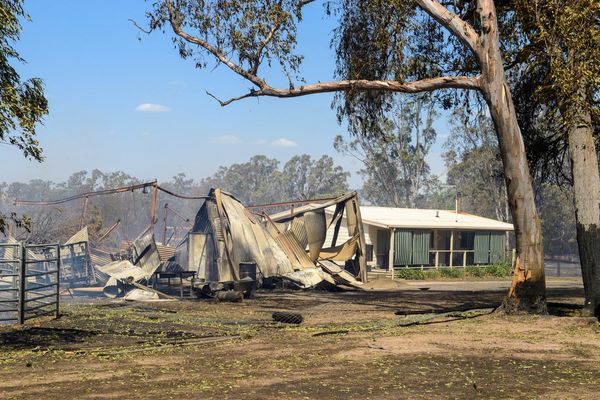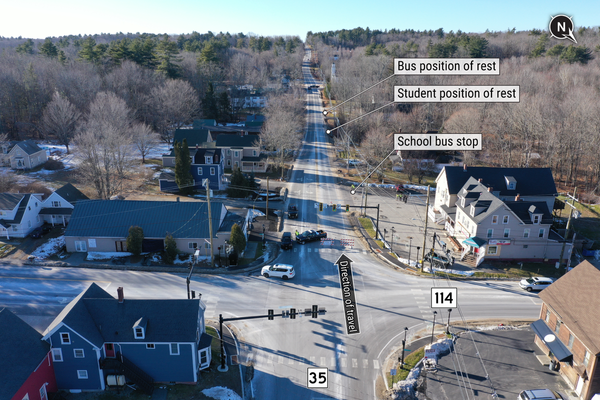
Agriculture was once king in Glen Beasley’s neighbourhood on Queensland’s Darling Downs, a vast agricultural area about 200km west of Brisbane. “It was all grain, beef, timber and a bit of coal,” he says.
Then a high voltage power line was built through his family farm outside Chinchilla in 1984. The whispers of gas came with the turn of the millennium, and by the early 2010s, the coal seam gas industry was booming. Gas company Arrow Energy now holds a tenement over his property and a few doors down, there’s a coal seam gas waste facility.
“Now we have traffic lights in town, more shops, and there’s a lot more people around,” Glen’s wife, Barbara Beasley, says. “But when gas first came into the area there was a lot of resentment,” Glen adds.
Today, expanding gas fields cover the landscape. Huge transmission lines crisscross fields of grazing cattle and crimson sorghum ready for harvest. Substations, pipelines and coal trains rolling by.
There is another player in the mix now too: renewable energy. There are at least 17 operating wind and solar farms in south-east Queensland, five under construction, and 31 more in the pipeline.
The majority of these projects are slated for the area Beasley’s family has been farming for three generations: the Western Downs, which sits at the heart of Nationals leader David Littleproud’s electorate of Maranoa. Littleproud has labelled Australia’s renewable rollout as “pure insanity”, and opposes the Queensland LNP’s decision to support the state government’s 75% emissions reduction target by 2035.
Littleproud says that his party isn’t against renewables, “but we are concerned that renewable projects are losing their social licence”.
Low-hanging fruit
Outside Littleproud’s office, the renewable energy transition is already in full swing. The Western Downs is one of the most developed of the Queensland government’s renewable energy zones – areas slated for a concentration of renewable projects.
Australia’s largest operating solar farm is just outside Chinchilla and joins at least seven other solar farms sitting next to power grid infrastructure built to support the fossil fuel industry. The co-location allows the area to sidestep the costly and contentious process of building new transmission lines.
Farms in the region are also generally larger and less fertile, which can make farmers more open to diversifying their income with energy developments, and, because of the gas industry, there is a skilled workforce already in place: one construction company alone, Western Downs Civil, employs 110 people and 60% of its work now comes from renewable projects.
“It’s the perfect low hanging fruit scenario,” says associate prof Kathy Witt, a principal research fellow at the University of Queensland’s Gas and Energy Transition Centre.
The region is so popular that developers are jockeying for space: the Beasleys were on the verge of signing a 30-year lease with a UK solar developer, before a surge of other solar projects caused the transmission line on his property to reach capacity.
“It was a very attractive proposition for us and our children … and we could have put it on the least productive country,” Glen says. “It seems almost inevitable they will upgrade [the line].”
The details of contracts between farmers and renewable developers are locked behind confidentiality agreements, but according to advocacy group Farmers for Climate Action the average annual compensation is about $40,000 a wind turbine and $1,500 a hectare of solar panels.
“For farmers its really significant income and it’s constant, its regular, while farming isn’t a regular income,” says Paul Hudson, a Western Downs grazier. “The more marginal [the land], the more it means to them.”
Hudson was speaking after a community meeting last week for a planned 100-turbine windfarm in Goombi, west of Chinchillla.
‘We haven’t learned’
The gas industry has laid the groundwork for the region’s renewable rollout, the director of the University of Southern Queensland’s Rural Economies Centre of Excellence, Prof Ben Lyons, says.
“The renewable sector had a whole case-study from this region about how to get communities onside … but we haven’t learned,” he says. “That’s the biggest regret I have about it.”
Lyons managed the community engagement process for AGL’s Coopers Gap windfarm in 2020-2021. He says the renewable energy industry lacks regulation and transparency, independent oversight and relies on the goodwill of project developers to build social licence in communities.
Larger companies may invest in a community to help build social licence to operate, but not all developers take that time.
A report by Andrew Dyer, a former Australian Energy Infrastructure Commissioner found some renewable energy companies have created anxiety and confusion in regional communities by not providing adequate information or properly addressing concerns.
In renewable energy zones, encroaching development can feel overwhelming. Some landowners on the Darling Downs have been approached by as many as 12 different renewable energy developers.
A prospective windfarm on the Southern Downs was shelved last month after a community meeting in the small town of Allora, where hundreds of people spilled from the doors of the local sports club in outrage over nine farmers being approached about a potential development.
The Southern Downs state Liberal MP, James Lister, told the crowd: “We do have to fight because in the city they love this shit.”
A spokesperson from Wind Prospect, the Melbourne-based energy developer who met with the landowners, says while they expect some level of community resistance, “it’s unusual to experience opposition before a project is actually proposed”.
Glen Beasley says the lack of factual information about renewable projects has left a vacuum for misinformation to flourish.
“I think partly it’s an indecent haste on the part of some locals to believe in conspiracies,” Beasley says. “It’s driven by the media too,” Barbara adds.
A Green Energy Markets report found the “remarkable” pace of recent renewable energy project approvals in Queensland has put it ahead of New South Wales in decarbonising its energy grid.
The Queensland government last week introduced legislation to expand the remit of the GasFields Commission to regulate the renewable energy rollout, under the new name “Coexistence Queensland”.
Lyons says the state “should have been on to that five years ago”. “We’ve had a lot of time to prepare for this, but we haven’t.”
Adrian Story, a grazier with gas wells on his property, has graduated from a leadership program that aims to equip people with the skills to manage the energy transition. Story says the gas industry “both helped and hindered” renewable developers.
“Gas made a lot of mistakes early on by not doing early engagement … in some cases I’m seeing those mistakes happen again with renewables,” he says.
Western Downs mayor, Andrew Smith, says the council, which has responsibility for approving solar projects but not gas or wind, fully supports the diversification of energy in the region.
“Let’s leave the politics to the politicians, we are here to take advantage of where our nation is heading,” Smith says.







